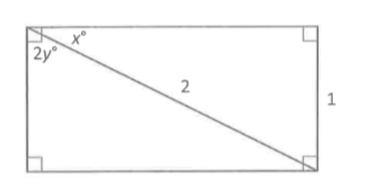−2≤x≤3
−3≤y≤2
Quantity AQuantity BThe maximum value of|x−4|The maximum value of |y+4|
Quantity A is greater.
Quantity B is greater.
The two quantities are equal.
The relationship cannot be determined from the infromation given.
The correct Answer is:C
To solve the problem, we need to find the maximum values of |x−4| and |y+4| given the constraints on x and y.
Step 1: Analyze the range of x
We are given the inequality:
−2≤x≤3
This means x can take any value from −2 to 3.
Step 2: Transform the expression |x−4|
We can rewrite the expression |x−4|:
|x−4|=|−(4−x)|=|4−x|
Next, we need to find the maximum value of |x−4| by considering the endpoints of the range of x.
Step 3: Calculate |x−4| at the endpoints
1. When x=−2:
|x−4|=|−2−4|=|−6|=6
2. When x=3:
|x−4|=|3−4|=|−1|=1
Step 4: Determine the maximum value of |x−4|
From the calculations:
- At x=−2, |x−4|=6
- At x=3, |x−4|=1
Thus, the maximum value of |x−4| is:
Maximum value of |x−4|=6
Step 5: Analyze the range of y
We are given the inequality:
−3≤y≤2
This means y can take any value from −3 to 2.
Step 6: Transform the expression |y+4|
We can rewrite the expression |y+4|:
|y+4|
Next, we need to find the maximum value of |y+4| by considering the endpoints of the range of y.
Step 7: Calculate |y+4| at the endpoints
1. When y=−3:
|y+4|=|−3+4|=|1|=1
2. When y=2:
|y+4|=|2+4|=|6|=6
Step 8: Determine the maximum value of |y+4|
From the calculations:
- At y=−3, |y+4|=1
- At y=2, |y+4|=6
Thus, the maximum value of |y+4| is:
Maximum value of |y+4|=6
Step 9: Compare the two quantities
Now we compare the two quantities:
- Quantity A: Maximum value of |x−4|=6
- Quantity B: Maximum value of |y+4|=6
Since both quantities are equal:
Quantity A=Quantity B
Conclusion
The two quantities are equal, so the answer is:
Option 3: The two quantities are equal.
We are given the inequality:
−2≤x≤3
This means x can take any value from −2 to 3.
We can rewrite the expression |x−4|:
|x−4|=|−(4−x)|=|4−x|
Next, we need to find the maximum value of |x−4| by considering the endpoints of the range of x.
1. When x=−2:
|x−4|=|−2−4|=|−6|=6
2. When x=3:
|x−4|=|3−4|=|−1|=1
From the calculations:
- At x=−2, |x−4|=6
- At x=3, |x−4|=1
Maximum value of |x−4|=6
We are given the inequality:
−3≤y≤2
This means y can take any value from −3 to 2.
We can rewrite the expression |y+4|:
|y+4|
Next, we need to find the maximum value of |y+4| by considering the endpoints of the range of y.
1. When y=−3:
|y+4|=|−3+4|=|1|=1
2. When y=2:
|y+4|=|2+4|=|6|=6
From the calculations:
- At y=−3, |y+4|=1
- At y=2, |y+4|=6
Maximum value of |y+4|=6
Now we compare the two quantities:
- Quantity A: Maximum value of |x−4|=6
- Quantity B: Maximum value of |y+4|=6
Quantity A=Quantity B
The two quantities are equal, so the answer is:
Option 3: The two quantities are equal.
Similar Questions
Knowledge Check
- Question 1 - Select One
Quantity AQuantity Bx3x−4
AQuantity A is greater.BQuantity B is greater.CThe two quantities are equal.DThe relationship cannot be determined from the infromation given. - Question 2 - Select One
Quantity AQuantity Bx22x
AQuantity A is greater.BQuantity B is greater.CThe two quantities are equal.DThe relationship cannot be determined from the infromation given. - Question 3 - Select One
|x−2|>3
Quantity AQuantity BThe minimum possible value ofThe minimum possible value of|x−3.5||x−1.5|AQuantity A is greater.BQuantity B is greater.CThe two quantities are equal.DThe relationship cannot be determined from the infromation given.


